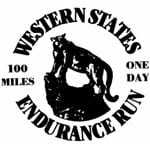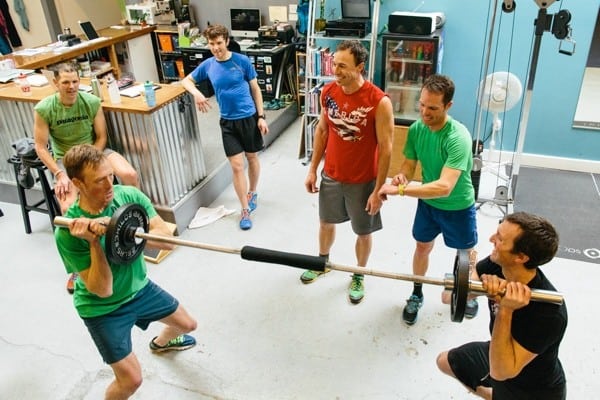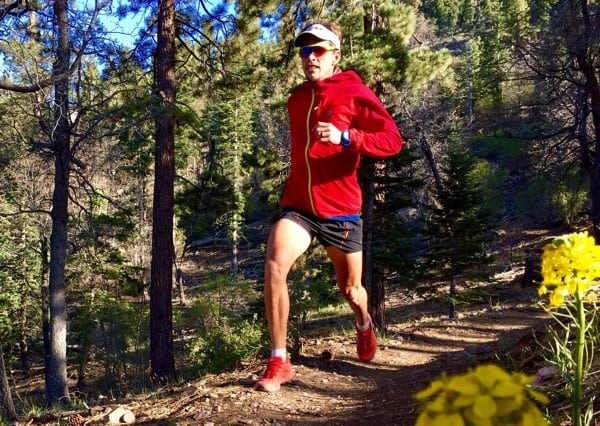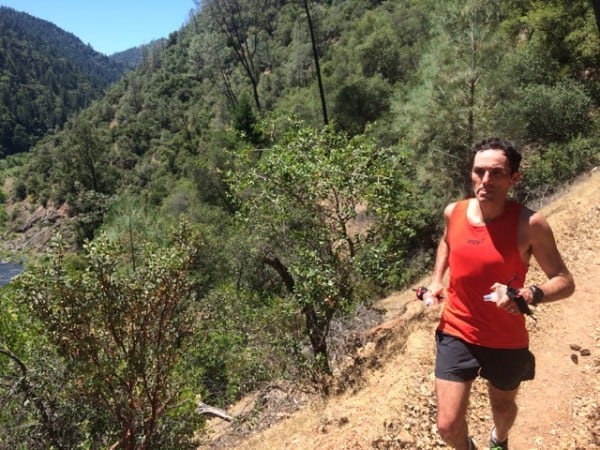 In the week before the 2015 Western States 100, we interviewed previous top placers Seth Swanson, Ryan Sandes, Dylan Bowman, and Brendan Davies. Seth took second last year at his first WS 100; Ryan clocked a second place in 2012 and a fifth place last year; DBo has finished seventh, fifth, and third the last three consecutive years; and Brendan rocked an eighth place in his first WS 100 last year.
In the week before the 2015 Western States 100, we interviewed previous top placers Seth Swanson, Ryan Sandes, Dylan Bowman, and Brendan Davies. Seth took second last year at his first WS 100; Ryan clocked a second place in 2012 and a fifth place last year; DBo has finished seventh, fifth, and third the last three consecutive years; and Brendan rocked an eighth place in his first WS 100 last year.
In the following interviews, Seth describes how he thinks the men’s race will play out, Ryan discusses his unfinished business with States, Dylan talks about whether he can realistically win this race, and Brendan paints a picture of his ideal day of racing.
Jump immediately to interviews with:
Be sure to check out our in-depth men’s preview as well as our other set of written interviews with Rob Krar, Jared Hazen, Ryan Bak, and Gediminus Grinius to see who else will join these guys in the men’s race.
Seth Swanson
iRunFar: You’re under no one’s radars anymore. You went into last year’s race a regional fan favorite. You had a group of people who knew your capabilities and that you’d perform well, but you exploded onto everyone else’s radar with your second place. Does this change how you approach your second WS 100, given that your success last year changes how other competitors will approach you?
Seth Swanson: It is certainly tough to have higher assumed expectations. It can definitely take a little of the edge off to just be some dude from Montana and keep that bar pretty low. But no matter what, the biggest pressures are endogenous.
iRunFar: Your race was so solid last year. You were just right there, lingering, all the way through. What’s your game plan this year? Have you tried other strategies in other races with success?
Swanson: On Saturday, my biggest priority is to stay within myself. Obviously much easier said than done, but I hope to be able to balance the efforts of staying competitive while remaining cognitive about my own capabilities. To some degree it is a race of attrition, and you just hope you have more in the tank than some of the other dudes. It is not going to be an easy task with so many strong and fast runners.
iRunFar: Your training lead-up to this race, can you talk a little bit about some of the training blocks you’ve had this spring? How you’ve organized your training? What are some of the key workouts, or pieces of your training?
Swanson: I’m not really one for huge volume, so I try to be a bit more deliberate with my day-to-day runs. I have a family and a job, which justifiably require a lot of time and energy as well, so I can’t really run all day or put in a huge workout and expect to just relax and recover the rest of the day. I’m really lucky to have a supportive and patient wife and some easygoing kids, but running is still quite demanding and ultimately selfish. It is just not sustainable for me to put in massive miles; certainly a tough balance to strike.
Challenging schedules this spring has kept some friends and I from getting together on a weekly basis for some varied feats of strength. Despite the void of these key sessions, I used many of those benchmarks set last year during my efforts this spring.
The weather has been unseasonably cooperative here in Montana and the trails have been in prime condition, albeit a bit dry for this time of year. Missoula’s proximity to endless trails makes it quite easy to shoe horn in some good runs. Missoula’s rich running community also provides some great opportunities to tune-up the legs.

Six dudes and a gym. Seth is holding the barbell on the left side. At Momentum AT, spring 2014. Photo: Tom Robertson/@thrphoto
iRunFar: Play ESPN for a minute, knowing what you know about the enormously talented men’s field, do you have any predictions for how the race is going to play out? Who is going to take things out? Who will be left after the canyons? Who will still be in it at the river crossing?
Swanson: It is pretty easy to sit on the couch and make some speculations about what is going to happen next Saturday, but when it comes down to it there are soooo many strong and talented runners and there are so many variables that it is hard to say. I don’t really keep up on everyone’s stats, but I don’t live completely in a bubble and expect that everyone is properly fit and mentally prepared. A couple of predictions that I can make are: one; it is going to be fast, and two; I don’t think Rob [Krar] will be alone at the river this year. I think the race is going to go to the end. However it ends up shaking out, I’m sure it is going to be exciting.
Ryan Sandes

Ryan Sandes
iRunFar: You have two WS 100 finishes, including a 15:03 second place. I think most guys would love to say they’ve 1.) finished second at States, and 2.) run a 15:03 here. What keeps you coming back? What degree of improvement do you think you could achieve? What do you want to do that you haven’t done?
Ryan Sandes: Western States is one of my favourite races and there is something very special about it. I would love to break 15 hours and finish one better than my second place in 2012, but 100 miles is a long way and anything can happen out there. Last year I felt I was a little over-raced and burnt out by the time I got to Western States, so this year I have really focused specifically on training and peaking for the race. I think this will be my last proper shot at winning Western States as next year I would like to try one or two new races.
iRunFar: As a multi-time international participant in one of the U.S.’s most competitive and historic ultras, have you started to feel a sense of kinship with the community that’s based around States and a connectedness to the place that comes with familiarity and challenging yourself there? How would you describe your relationship with the race?
Sandes: Yes for sure and I think that whats makes the race so special. We (Vanessa and I) have spent a fair amount of time in the area over the past few years and made some great friends. On my first visit to Western States, I found myself very lost on the trails and luckily I stumbled into Bill Rose, who was also training for the race. He was super friendly and showed me a lot of the Western States route. We have since become really good friends and always stay with Bill and his wife, Teresa, when we are in Auburn. Vanessa always jokes and calls Bill, Teresa, and their friends Tony, Cathy, and Chaz our American family. I have gotten to meet a lot of the local communities around the race and Western States will always be a very special race for me.
iRunFar: You basically came straight to America following Transvulcania in May. Can you walk us through what your training has looked like while being here? Your training block? An example week? Some of your key workouts?
Sandes: I have spent just over a month in Big Bear, California exploring some new mountains and get some altitude training in. This is my eighth year of running ultras now, so I have really tried to listen to my body and train smart. It’s important to get some big miles in for a 100 miler but at the same time you need to hit the start line feeling fresh. My average training week up at Big Bear was 14 or 15 hours and would generally include one to two long runs a week of 3.5-plus hours. I really felt the altitude in the first two weeks so I took it quite easy to make sure I was recovering properly. Generally I would also do about two quality sessions a week of hill repeats and some tempo running but nothing more than 80% of my max heart rate as I didn’t want too take too long to recover. I have had a really good four- to five-week block of consistent but conservative training.

Ryan training in Big Bear. Photo: Vanessa Haywood
iRunFar: The men’s race is really interesting. There are a ton of returnees from last year’s top 10. There’s some international influx. There is a fascinating group of American ‘young guns’ who’ve earned entry through the Montrail Ultra Cup. Can you predict the racing dynamic? Who might go off the front? Who are the guys who are going to be around all day, start to near-finish? Who are the guys who are really going to come on strong later in the race?
Sandes: It will be a really exciting race with a great field of runners. I think the race only really starts from Foresthill but with such a strong group of runners I am sure some of the guys will start off fairly fast. I think Dylan [Bowman] and Rob [Krar] will be really strong; they both know the course well and run smart races. I would imagine they would both be looking to up their tempo from Foresthill to the finish. It will be interesting to see how guys like François [D’Haene] and Julien [Chorier] do on slightly flatter terrain to what they are used to. It’s really hard to pick any specific runners though, as there is such a great field and I am sure there will be a number of surprises. The weather will also play a huge role but I think in general times will be fairly fast to Foresthill this year, and then I think it will be a real battle for the finish line. I am excited and really looking forward to the race and the whole experience that goes with it. In 20 years I won’t remember the exact time I ran the 2015 Western States in, but I will remember my whole day’s experience.
Dylan Bowman

Dylan Bowman
iRunFar: Dude, you are on a bleeping roll this year. Your international success so far means that a lot of people are pointing toward you as someone who could do real damage at States. You were third last year. What the heck does that mean? Are you going to win this thing? Can you win? What is going on in your head right now? What’s the mind saying to the heart and the heart saying to the mind?
Dylan Bowman: Ever since I started running, I’ve dreamt of one day winning Western States. In my opinion, it’s the greatest race in the world and I’m fortunate to have a fourth opportunity to try. There’s no question I’m better prepared than ever. My training has been bigger and better than last year and my racing has reflected my improvement. Plus, the course suits me and I have a lot of experience at the race. All those things make me optimistic that I’m prepared to have my best Western States yet. That said, I think it will take right around 15 hours (or under) to win the race going forward. If I’m being honest with myself, on a perfect day, I think 15:15 to 15:20 is probably my ceiling at this point. In my three finishes, I’ve learned that champions at this race have to take at least one big risk during the day. If I’m in a position to win, I’m fully prepared to do that. But my focus will be on remaining consistent and keeping a competitive mindset all the way to Auburn.
iRunFar: DBo Sports Center time, one of my favorite parts of pre-Western States fun with you. You’ve got the top-10 returnees. You’ve got the international influx. You have some American upstarts as well as a couple long-time scene dominators via the Montrail Ultra Cup. Take us to the race at 20 miles in. How about to Michigan Bluff? What does the field look like at the river? Will the race come down to the last miles or be decided earlier?
Bowman: I enjoy a bit pf pre-race speculation. I think the racing dynamic will be greatly influenced by how the European contingent chooses to approach the opening miles. If they go out hard–as they tend to do on their home turf–there will definitely be a few others who give chase and the field will string out quickly. If not, I think we’ll see a large lead pack together at Duncan Canyon before things string out a bit on the climb to Robinson. As always, the field will splinter further in the canyons and the real contenders will find their way to the front by Michigan Bluff.
In my mind, there aren’t many scenarios I envision in which Rob Krar doesn’t win the race. From my perspective, the race course seems tailor made for his strengths and he’s probably the most physically talented runner in the field. If he’s in contention at Foresthill, he will win. If he is vulnerable on the day, I think Ryan Sandes, Seth Swanson, and Alex Varner have the class and talent to win. Although the course isn’t in his wheel house, I think François will find his way onto the podium and Ian Sharman will have his best race yet. Both the men’s and women’s records are safe for at least another year, though.

Dylan doing trail work on the Western States Trail in Deadwood Canyon. Photo: Gary Wang
iRunFar: The DBo support crew, who’s on it? Who’s doing what? What does your support team look like this year?
Bowman: As always, I have an obnoxiously large cheer squad. My family loves this sport as much as I do and they will be out in force once again. My girlfriend, Harmony, takes care of the important stuff and my brother, Jason, is the spiritual leader and calming influence. For pacers I have the fastest Mill Valley resident you’ve never heard of, Michael Hiscott, escorting me from Foresthill to the River and good buddy James Bonnett taking the anchor leg. I will be very well looked after.
iRunFar: Something you do really well, you play nice with other ultrarunners, you make everyone your friend. That doesn’t mean you don’t want to beat everyone, but you are a gentleman to everyone. So, if you can’t win this race, who would you really like to see win and why? Who is really primed and ready to go?
Bowman: I’d love to see Alex Varner bring a cougar back to Mill Valley. As he showed at Lake Sonoma, he is sickly talented and can compete with the best. Ann Trason graciously donated one of her 14 cougars to the San Francisco Running Company, but we could use another.
Brendan Davies

Brendan Davies
iRunFar: You’re back. You had an incredible race here last year, running to eighth place in a really competitive field. It has to rank up there among your best-ever achievements as an ultrarunner. How does it feel to have carried this badge of pride around for the last year? And how does it feel to return to a place and a race that ‘treated’ you so well?
Brendan Davies: Hey Meghan, thanks so much for the warm welcome. I’m loving being back in California; it’s just a great place to be at any time of the year and just a bonus to be back for something I love doing. I’m honoured to be back with the M8 bib. It’s been my big A race all year and I’m itching to get out back there and do my best. Stepping back on the trails the WS trails these last couple of days feels like when you walk into your favourite bar and take a swig of your favourite beer; I feel these trails play to my strengths and that just is so calming in the lead up. I feel pretty confident that I can put in another good run.
iRunFar: Can you replay for us your The North Face 100k – Australia race? If I understand correctly, you went into the race pretty fit and strong but didn’t have a good day. Give us the play-by-play of your day.
Davies: Yeah I guess pretty physically fit but not really rested nor enough time for the mental preparation. It’s been an incredibly busy year with my coaching business and I just wasn’t quite in the right headspace from the get go. I was up with the lead guys for about 30k, then I slowly drifted back. The pace was pretty incredible from the front guys and physically it was a little too much. I ran the next 50k or so with a couple of the international runners hovering in and out of the top 10. I was a little disappointed with myself late in the race as mentally I didn’t fight for my positions and lost quite a few spots I could have held onto; walking a lot of the last big climb rather than squeezing the last big effort out of myself. It’s my local event, so second Aussie home was still a good result but far from what I would have liked in the overall placings.
iRunFar: Paint a picture of your best race here at States. Who might you run with? How do you feel? Where on the course you push and relax? The outcome?
Davies: I guess I just want to run my own race and not get pushed into racing others or running outside my zone of control. You really need to manage your body well through the heat and on the big climbs and I’ll try to find that perfect balance of effort, fatigue, and pace in order to run optimally the whole 100 miles. Sounds much easier said than done of course and in reality only a small percentage will succeed at this and I’m no different; at some stage there will be self-inflicted problems so I’ll also need to troubleshoot pretty quickly out there. If there’s one section I want to get to feeling reasonably fresh so I can push through it would be California Street. I did this section pretty well last year and that set me up for my good time, and a good outcome.
Another Aussie, Andrew Tuckey, is one to watch. We have had great battles over the years but he’s taken a huge leap forward the last year or so. I can see us running some of it together for some of the beginning legs. Last year I ran a bit with Ian Sharman and Alex Varner, so I’ll be doing well to be running with a calibre of runners like that again.
iRunFar: I have to ask about the beard. It’s getting bigger, fluffier, wider. I’m not sure if those the correct descriptors. Does the beard signify anything? How do you think it will do in the heat? Is there any danger of you being mistaken for a wild animal in the American wilderness?
Davies: Ha ha, yeah, I think ‘wild’ is the word the summarises it all! No, there isn’t any deeper message really, it’s just been a case of partly being too lazy to shave and then as we started to enter the Aussie winter I found it actually served a purpose keeping my face kind of warm as I do a lot of my work outside, on the trails, and in the cold weather. I’d love to know how it performs in the heat, too. We will just have to wait and see…well maybe. Being mistaken for wild game over here is far from safe. [Editor’s Note: Brendan shaved his big beard off right after this interview!]

Brendan running in California right after he shaved his beard. Photo courtesy of Brendan Davies.

Brendan with THE beard that is no more. Photo courtesy of Brendan Davies.
